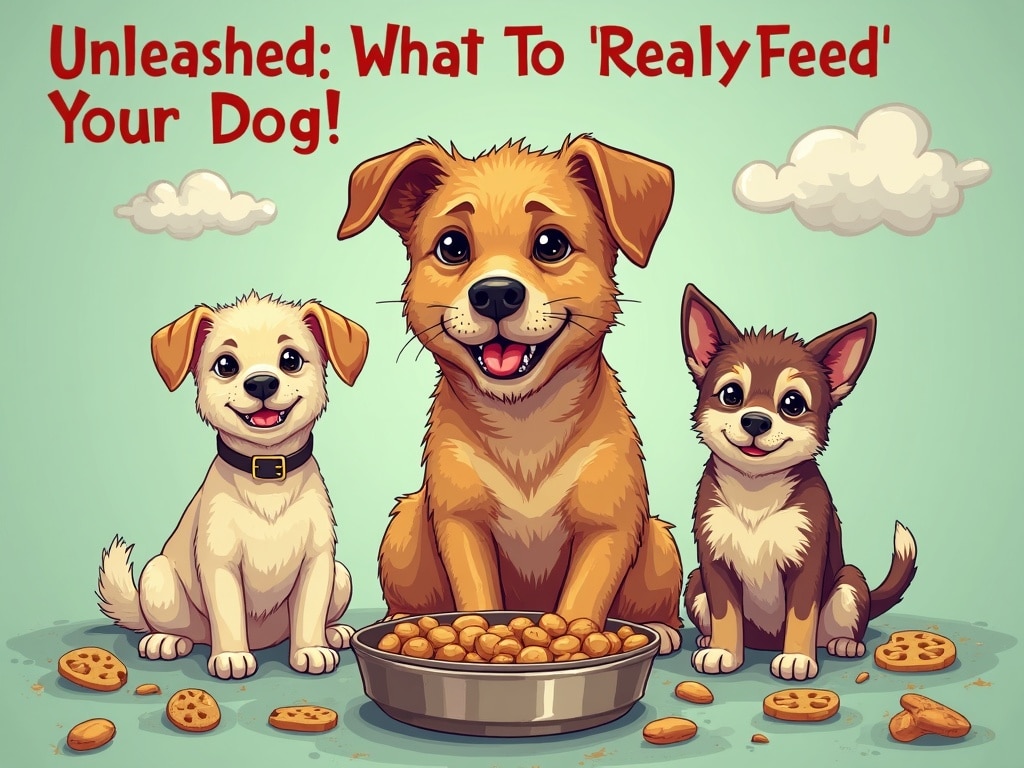Unleashed: Decoding What to *ReallyFeed Your Dog
The dog food aisle. A dizzying expanse of bags, cans, and promises. Glossy photos of happy, healthy dogs stare back at you, each brand vying for your attention and your dollars. But behind the marketing hype, lies a crucial decision: what to *reallyfeed your dog. It's not as simple as grabbing the cheapest bag or the one with the cutest puppy on the label. Your dog's diet is the foundation of their health, longevity, and overall well-being, so understanding their nutritional needs and the options available is paramount. Are you ready to cut through the confusion and unleash the best possible diet for your furry friend?
Nutritional Needs of Dogs: The Building Blocks of a Healthy Pup
Think of your dog's body as a complex machine. To run smoothly, it needs the right fuel, and that fuel comes in the form of essential nutrients. Here's a breakdown:
- Protein: The cornerstone of muscle development, tissue repair, and enzyme production. Think of it as the construction crew building and maintaining your dog's physique.
- Fats: A vital energy source that also supports hormone production and healthy skin and coat. Healthy fats are like the lubricant keeping the engine running smoothly.
- Carbohydrates: While not strictly essential, carbs provide energy and fiber. These are the secondary fuel source, providing a boost when needed.
- Vitamins & Minerals: These micronutrients are crucial for a wide range of bodily functions, from immune system support to bone health. They're the essential tools in the toolbox, keeping everything working properly.
- Water: Often overlooked, adequate hydration is absolutely critical for all bodily functions. Water is the lifeblood, transporting nutrients and removing waste.
Nutritional needs aren't one-size-fits-all. A growing puppy needs more protein and calories than a senior dog. A highly active Border Collie will require a different balance than a sedentary Bulldog. Breed also plays a role, as some breeds are predisposed to specific nutritional deficiencies or sensitivities. Ignoring these individual needs can lead to serious health problems, including stunted growth, obesity, joint problems, and organ dysfunction.
Decoding Dog Food Labels: A Crash Course in Canine Nutrition
That ingredient list on the back of the bag can feel like a foreign language. But with a little knowledge, you can decipher the code and make informed choices for your dog.
- The Ingredient List: Ingredients are listed in descending order by weight. The first few ingredients make up the bulk of the food. Look for named meat sources (e.g., chicken, beef, lamb) as the primary ingredients, not generic terms like meat meal or animal by-products.
- Complete and Balanced: This phrase indicates that the food is formulated to meet the nutritional standards established by the Association of American Feed Control Officials (AAFCO) for a specific life stage (e.g., growth, adult maintenance, all life stages). It's a good starting point, but doesn't guarantee high-quality ingredients.
- Red Flags: Be wary of excessive fillers (corn, wheat, soy), artificial colors and flavors, and vague ingredient terms. Also, question long lists of synthetic vitamins and minerals, which may indicate a lack of naturally occurring nutrients from whole food sources.
Kibble: The Convenient Choice – But at What Cost?
Kibble is the most popular dog food for a reason: it's convenient, readily available, and generally affordable. It also offers some dental benefits, as the crunchy texture can help reduce plaque buildup.
However, kibble also has potential drawbacks. The high-heat processing methods used to create kibble can destroy some nutrients, requiring manufacturers to add synthetic vitamins and minerals back in. The ingredient quality can also vary widely, with some kibble brands relying heavily on inexpensive fillers and processed ingredients. Finding a high-quality kibble means digging deeper. Look for brands that prioritize whole food ingredients, use gentle cooking methods, and have a good reputation for quality control.
Fresh Food Diets: Bringing the Kitchen to the Bowl
Fresh dog food diets are gaining popularity, and for good reason. They typically contain high-quality, human-grade ingredients that are gently cooked or minimally processed, preserving more nutrients than traditional kibble. Many owners report improvements in their dog's digestion, energy levels, coat health, and overall well-being.
The challenges? Fresh food diets can be more expensive than kibble, and they require more preparation and storage. You either need to cook the food yourself or purchase pre-made meals from a reputable company. To ensure your fresh food diet is nutritionally complete, it's crucial to follow a recipe formulated by a veterinary nutritionist or to choose a commercially prepared diet that meets AAFCO standards.
Raw Food Diets: A Return to Ancestral Roots?
Raw food diets, often referred to as the BARF (Biologically Appropriate Raw Food) diet, are based on the idea that dogs should eat what their wild ancestors ate. These diets typically consist of raw meat, bones, and organs, along with some fruits and vegetables.
Proponents claim that raw feeding improves digestion, strengthens the immune system, and enhances coat health. However, the risks associated with raw feeding are significant. Bacterial contamination (Salmonella, E. coli) is a major concern, posing a threat to both your dog and your family. Nutritional imbalances are also possible if the diet is not properly formulated. If you choose to feed a raw diet, it's essential to work with a veterinarian or canine nutritionist to ensure it's safe and nutritionally complete, and to follow strict food safety guidelines.
Navigating the Dietary Maze: Grain-Free, Supplements, and Allergies
The world of dog nutrition is full of trends and controversies. Here's how to navigate some common questions:
- Grain-Free Diets: Unless your dog has a diagnosed grain allergy, there's no inherent benefit to grain-free diets. In fact, some grain-free foods have been linked to heart problems in dogs. The focus should be on ingredient quality, not on avoiding grains.
- Supplements: A well-balanced diet should provide most of the nutrients your dog needs. However, supplements may be beneficial in certain situations, such as joint support for senior dogs or digestive enzymes for dogs with digestive issues. Always consult with your veterinarian before adding supplements to your dog's diet.
- Food Allergies and Sensitivities: If your dog is experiencing skin problems, digestive upset, or other signs of food sensitivity, an elimination diet can help identify the culprit. Work with your veterinarian to create a plan that gradually eliminates potential allergens from your dog's diet.
Transitioning to a New Diet: A Gradual Shift for Happy Tummies
Switching your dog's food abruptly can lead to digestive upset. A gradual transition is key. Start by mixing a small amount of the new food with the old food, gradually increasing the proportion of the new food over 7-10 days. Watch for signs of digestive distress, such as diarrhea or vomiting. If your dog experiences any problems, slow down the transition or consult with your veterinarian.
Seeking Expert Advice: When to Consult a Professional
If you're feeling overwhelmed or unsure about your dog's nutritional needs, don't hesitate to seek professional guidance. A veterinarian or canine nutritionist can assess your dog's individual needs and recommend a diet that's right for them.
When choosing a professional, look for someone with a strong background in canine nutrition. Ask about their qualifications, experience, and approach to diet formulation. Don't be afraid to ask questions and express your concerns.
The Bottom Line: Cost Considerations for Different Diets
The cost of dog food can vary significantly depending on the type of food you choose. Kibble is generally the most affordable option, while fresh food and raw food diets tend to be more expensive. However, it's important to consider the long-term cost of your dog's health. A high-quality diet can help prevent health problems and reduce the need for expensive veterinary care.
Also, consider the time commitment involved. Preparing fresh or raw food at home requires more time and effort than simply scooping kibble into a bowl. Dog puzzle toys can help engage dogs that are eating the same foods long term.
Ultimately, the best diet for your dog is one that meets their nutritional needs, fits your budget, and aligns with your values. By understanding the different options available and working with your veterinarian or canine nutritionist, you can unleash the full potential of your dog's health and happiness.


